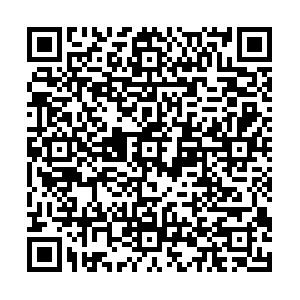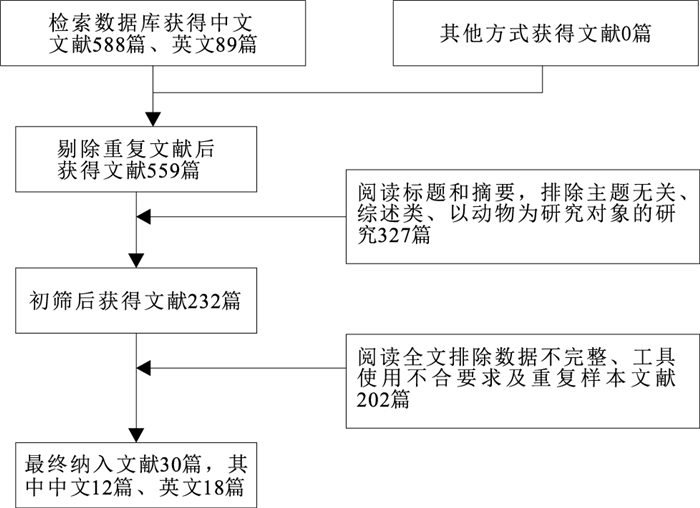Meta-analysis of the relationship between childhood abuse and social anxiety
-
摘要:
目的 了解儿童期虐待经历与社交焦虑的关系及其影响因素,为青少年社交焦虑的干预提供理论依据。 方法 采用随机效应模型,对筛选后获得的30篇文献,93个独立效应值,19 354个样本量进行元分析,采用比值比(OR)对两者之间关系进行整合。 结果 儿童期虐待与社交焦虑呈正相关(r=0.22),情感虐待(EA)、情感忽视(EN)、情感虐待综合指数(EM)、身体虐待(PA)、身体忽视(PN)、性虐待(SA)亚类型均正向预测社交焦虑(OR值分别为3.14,1.97,2.42,1.78,1.68,1.54)(P值均 < 0.01)。调节效应分析发现,文化背景能调节EN和儿童期虐待综合指数(CI)与社交焦虑的关系(Qb值分别为3.95,3.93),年龄阶段能调节EA、CI与社交焦虑的关系(Qb值分别为7.65, 8.72)(P值均 < 0.05)。 结论 儿童期虐待正向预测社交焦虑,文化背景、年龄阶段在儿童期虐待与社交焦虑的关系间存在调节效应, 而性别不存在调节效应。 Abstract:Objective To understand the relationship between childhood abuse and social anxiety and its influencing factors, so as to provide a theoretical basis for the intervention targeting social anxiety in adolescents. Methods The Meta-analysis was conducted on the 30 selected articles using random-effects models, comprising 93 independent effect sizes and a total sample of 19 354. Odds ratio (OR) was used to integrate the relationship between childhood abuse and social anxiety. Results There was a significant positive correlation between childhood abuse and social anxiety (r=0.22), and its subtypes (emotional abuse, emotional neglect, emotional maltreatment, physical abuse, physical neglect, sexual abuse) could also positively predict social anxiety (OR=3.14, 1.97, 2.42, 1.78, 1.68, 1.54)(P < 0.01). The moderating effect showed that cultural background could significantly moderate the relationship between emotional neglect and the composite index and social anxiety (Qb=3.95, 3.93), and the relationship between emotional abuse and composite index and social anxiety were significantly moderated by age (Qb=7.65, 8.72)(P < 0.05). Conclusions Childhood abuse is a positive predictor of social anxiety. Cultural background and age have a significant moderating effect on the relationship between childhood abuse and social anxiety, but gender has no significant moderating effect. -
Key words:
- Child abuse /
- Anxiety /
- Mental health /
- Child
1) 利益冲突声明 所有作者声明无利益冲突。 -
表 1 纳入儿童期虐待与社交焦虑关系文献的发表偏倚检验结果
Table 1. Results of publication bias test for the included literatures on the relationship between childhood maltreatment and social anxiety
虐待类型 Classic Fail-Safe N Egger's Intercept 标准误 LL值 UL值 P值 EA 3 694 -2.92 1.63 -6.36 0.53 0.09 EN 1 262 -1.93 2.67 -7.62 3.76 0.48 EM 154 0.41 3.56 -10.91 11.72 0.92 PA 325 -1.17 1.32 -4.15 1.80 0.40 PN 360 -3.12 1.40 -6.23 -0.07 0.05 SA 203 -0.25 1.06 -2.62 2.11 0.81 CI 2 232 -1.96 1.96 -6.12 2.19 0.33 合计 2 111 -1.51 0.85 -3.20 0.19 0.08 表 2 儿童期虐待与社交焦虑关系研究的异质性检验
Table 2. Heterogeneity of studies on the relationship between childhood maltreatment and social anxiety
虐待类型 Q值 df值 P值 I2值 Tau2值 EA 113.18 17 < 0.01 84.98 0.16 EN 238.90 16 < 0.01 93.30 0.39 EM 5.88 4 >0.05 31.98 0.02 PA 29.30 10 < 0.01 65.87 0.06 PN 50.45 11 < 0.01 78.19 0.11 SA 19.83 11 < 0.05 44.53 0.02 CI 146.90 17 < 0.01 88.43 0.20 合计 827.77 92 < 0.01 88.89 0.22 表 3 儿童期虐待及亚类型与社交焦虑关系的随机效应模型分析
Table 3. Random-effects model analysis of the relationship between childhood maltreatment and subtypes and social anxiety
虐待亚型 r值 OR值(95%CI) Z值 P值 EA 0.30 3.14(2.54~3.87) 10.63 < 0.01 EN 0.18 1.97(1.44~2.70) 4.21 < 0.01 EM 0.24 2.42(2.00~2.93) 9.06 < 0.01 PA 0.16 1.78(1.48~2.14) 6.08 < 0.01 PN 0.14 1.68(1.35~2.09) 4.61 < 0.01 SA 0.12 1.54(1.34~1.77) 6.18 < 0.01 CI 0.22 2.28(1.81~2.85) 7.12 < 0.01 合计 0.20 1.97(1.82~2.12) 17.88 < 0.01 表 4 儿童期虐待及亚类型与社交焦虑关系的调节效应分析
Table 4. Moderating effect analysis of the relationship between childhood maltreatment and subtypes and social anxiety
调节变量 虐待类型 类别 OR值(95%CI) Qb值 P值 文化背景 EN 东方文化 1.58(1.15~2.17) 3.95 0.05 西方文化 2.74(1.77~4.25) CI 东方文化 2.51(1.90~3.33) 3.93 0.05 西方文化 1.77(1.44~2.17) 年龄阶段 EA 青少年 3.76(2.88~4.91) 7.65 0.02 成人 3.17(2.01~5.01) 成年早期 2.12(1.56~2.88) CI 青少年 2.91(1.92~4.43) 8.72 0.01 成人 1.67(1.47~1.90) 成年早期 2.25(1.69~3.00) -
[1] SHARRATT K, MASON S J, KIRKMAN G, et al. Childhood abuse and neglect, exposure to domestic violence and sibling violence: profiles and associations with sociodemographic variables and mental health indicators[J]. J Interpers Violence, 2023, 38(1/2): 1141-1162. [2] NESS S. A narrow focus in research on emotional abuse: a scoping review of definitions and descriptions on emotional abuse in research on child welfare and social work[J]. Child Fam Soc Work, 2023, 28(2): 572-588. doi: 10.1111/cfs.12967 [3] 郭夏玫, 黄靖雯. 大学生童年创伤和校园被欺凌经历与社交焦虑和生活满意度的关系[J]. 中国心理卫生杂志, 2022, 36(9): 810-816. https://www.cnki.com.cn/Article/CJFDTOTAL-ZXWS202209015.htmGUO X M, HUANG J W. Relation of childhood maltreatment and school bullying victim experience to social anxiety and life satisfaction in college students[J]. Chin Ment Health J, 2022, 36(9): 810-816. (in Chinese) https://www.cnki.com.cn/Article/CJFDTOTAL-ZXWS202209015.htm [4] CHEN C, QIN J. Emotional abuse and adolescents' social anxiety: the roles of self-esteem and loneliness[J]. J Fam Violence, 2020, 35: 497-507. doi: 10.1007/s10896-019-00099-3 [5] FITZGERALD M, GALLUS K. Emotional support as a mechanism linking childhood maltreatment and adult's depressive and social anxiety symptoms[J]. Child Abuse Negl, 2020, 108: 104645. doi: 10.1016/j.chiabu.2020.104645 [6] WANG Z J, LIU C Y, WANG Y M, et al. Childhood psychological maltreatment and adolescent depressive symptoms: exploring the role of social anxiety and maladaptive emotion regulation strategies[J]. J Affect Disord, 2024, 344: 365-372. doi: 10.1016/j.jad.2023.10.046 [7] 孟现鑫, 俞德霖, 陈怡静, 等. 儿童期创伤与共情的关系: 一项三水平元分析[J]. 心理学报, 2023, 55(8): 1285-1303. https://www.cnki.com.cn/Article/CJFDTOTAL-XLXB202308007.htmMENG X X, YU D L, CHEN Y J, et al. Association between childhood maltreatment and empathy: a three-level Meta-analytic review[J]. Acta Psychol Sinca, 2023, 55(8): 1285-1303. (in Chinese) https://www.cnki.com.cn/Article/CJFDTOTAL-XLXB202308007.htm [8] LIPSEY M W, WILSON D B. Practical Meta-analysis[M]. New York: Sage Publications, 2001: 49. [9] 于增艳, 赵阿勐, 刘爱书. 儿童期受虐经历与抑郁的元分析[J]. 心理学报, 2017, 49(1): 40-49. https://www.cnki.com.cn/Article/CJFDTOTAL-XLXB201701004.htmYU Z Y, ZHAO A M, LIU A S. Childhood maltreatment and depression: a Meta-analysis[J]. Acta Psychol Sinca, 2017, 49(1): 40-49. (in Chinese) https://www.cnki.com.cn/Article/CJFDTOTAL-XLXB201701004.htm [10] VAN AGTEREN J, IASIELLO M, LO L, et al. A systematic review and Meta-analysis of psychological interventions to improve mental wellbeing[J]. Nat Hum Behav, 2021, 5(5): 631-652. doi: 10.1038/s41562-021-01093-w [11] LIU J, DENG J, ZHANG H, et al. The relationship between child maltreatment and social anxiety: a Meta-analysis[J]. J Affect Disord, 2023, 329: 157-167. doi: 10.1016/j.jad.2023.02.081 [12] 谭贤. 儿童期虐待与社交焦虑的关系: 影响因素及干预[D]. 兰州: 西北大学, 2004.TAN X. The relationship between childhood and social anxiety: influence factors and intervention studies[D]. Lanzhou: Northwest Normal University, 2004. (in Chinese) [13] GARDNER M J, THOMAS H J, ERSKINE H E. The association between five forms of child maltreatment and depressive and anxiety disorders: a systematic review and Meta-analysis[J]. Child Abuse Negl, 2019, 96: 104082. doi: 10.1016/j.chiabu.2019.104082 [14] CARLTON C N, GARCIA K M, SULLIVAN-TOOLE H, et al. From childhood maltreatment to adult inflammation: evidence for the mediational status of social anxiety and low positive affect[J]. Brain Behav Immun Health, 2021, 18: 100366. doi: 10.1016/j.bbih.2021.100366 [15] 叶佳滢. 童年期心理虐待与大学生社交焦虑的关系: 应对方式的中介作用[J]. 心理学进展, 2023, 13(3): 885-892. https://www.cnki.com.cn/Article/CJFDTOTAL-XLYK202412063.htmYE J Y. The relationship between child psychological abuse and college students' social anxiety: the mediating effect of coping styles[J]. Adv Psychol, 2023, 13(3): 885-892. (in Chinese) https://www.cnki.com.cn/Article/CJFDTOTAL-XLYK202412063.htm [16] MÜLLER L E, BERTSCH K, BÜLAU K, et al. Emotional neglect in childhood shapes social dysfunctioning in adults by influencing the oxytocin and the attachment system: results from a population-based study[J]. Int J Psychophysiol, 2019, 136: 73-80. doi: 10.1016/j.ijpsycho.2018.05.011 [17] MYERS N S, LLERA S J. The role of childhood maltreatment in the relationship between social anxiety and dissociation: a novel link[J]. J Trauma Dissoc, 2020, 21(3): 319-336. doi: 10.1080/15299732.2020.1719265 [18] 张建人, 孟凡斐, 凌辉, 等. 童年期虐待、父母教养方式、不安全依恋与大学生反社会人格障碍的关系[J]. 中国临床心理学杂志, 2021, 29(1): 28-32. https://www.cnki.com.cn/Article/CJFDTOTAL-ZLCY202101006.htmZHANG J R, MENG F F, LING H, et al. Relationship among childhood abuse, parenting styles, attachment, and antisocial personality disorder in college students[J]. Chin J Clin Psychol, 2021, 29(1): 28-32. (in Chinese) https://www.cnki.com.cn/Article/CJFDTOTAL-ZLCY202101006.htm [19] 伍艳, 杨春. 大学生童年期情感虐待与抑郁情绪: 同伴依恋和心理弹性的中介作用[J]. 心理学进展, 2021, 11(9): 2235-2240. https://www.cnki.com.cn/Article/CJFDTOTAL-XLYK202010005.htmWU Y, YANG C. College students' childhood emotional maltreatment and depression: the mediating role of peer attachment and resilience[J]. Adv Psychol, 2021, 11(9): 2235-2240. (in Chinese) https://www.cnki.com.cn/Article/CJFDTOTAL-XLYK202010005.htm [20] 金童林, 陆桂芝, 张璐, 等. 儿童期心理虐待对青少年网络受欺负的影响: 社交焦虑的中介作用[J]. 中国临床心理学杂志, 2017, 25(1): 100, 167-170. https://www.cnki.com.cn/Article/CJFDTOTAL-ZLCY201701037.htmJIN T L, LU G Z, ZHANG L, et al. Psychological maltreatment and cyber victimization in adolescents: mediating of social anxiety[J]. Chin J Clin Psychol, 2017, 25(1): 100, 167-170. (in Chinese) https://www.cnki.com.cn/Article/CJFDTOTAL-ZLCY201701037.htm [21] 张建人, 周彩萍, 黄涛, 等. 亲子依恋与留守初中生自立人格的关系: 一个链式中介模型[J]. 中国临床心理学杂志, 2022, 30(2): 408-413. https://www.cnki.com.cn/Article/CJFDTOTAL-ZLCY202202031.htmZHANG J R, ZHOU C P, HUANG T, et al. Parent-child attachment and self-supporting personality in left-behind junior middle school students: a chain mediating model[J]. Chin J Clin Psychol, 2022, 30(2): 408-413. (in Chinese) https://www.cnki.com.cn/Article/CJFDTOTAL-ZLCY202202031.htm [22] BRÜHL A, KLEY H, GROCHOLEWSKI A, et al. Childhood maltreatment peer victimization, and social anxeity in childhood: a cross-sectional study in a treatment-seeking sample[J]. BMC Psychiatry, 2019, 19(1): 1-11. doi: 10.1186/s12888-018-1996-0 [23] WANG Z J, LIU C Y, WANG Y M, et al. Childhood psychological maltreatment and adolescent depressive symptoms: exploring the role of social anxiety and maladaptive emotion regulation strategies[J]. J Affect Disord, 2024, 344: 365-372. doi: 10.1016/j.jad.2023.10.046 [24] FEVRE R, GUIMAR E S, ZHAO W. Parents, individualism and education: three paradigms and four countries[J]. Rev Educ, 2020, 8(3): 693-726. doi: 10.1002/rev3.3204 [25] CHEN S H, ZHOU Q, MAIN A, et al. Chinese American immigrant parents' emotional expression in the family: relations with parents' cultural orientations and children's emotion-related regulation[J]. Cult Divers Ethnic Minor Psychol, 2015, 21(4): 619-629. doi: 10.1037/cdp0000013 [26] LIPPARD E T C, NEMEROFF C B. The devastating clinical consequences of child abuse and neglect: increased disease vulnerability and poor treatment response in mood disorders[J]. Am J Psychiatry, 2020, 177(1): 20-36. doi: 10.1176/appi.ajp.2019.19010020 [27] 曹俊, 聂胜楠, 李梦然, 等. 遵义市受艾滋病影响中学生社交焦虑现状及影响因素[J]. 中国学校卫生, 2018, 39 (11): 1697-1699. doi: 10.16835/j.cnki.1000-9817.2018.11.027CAO J, NIE S N, LI M R, et al. Current situation and influencing factors of social anxiety among middle school students affected by HIV/AIDS in Zunyi City[J]. Chin J Sch Health, 2018, 39 (11): 1697-1699. (in Chinese) doi: 10.16835/j.cnki.1000-9817.2018.11.027 [28] JEFFERIES P, UNGAR M. Social anxiety in young people: a prevalence study in seven countries[J]. PLoS One, 2020, 15(9): e0239133. doi: 10.1371/journal.pone.0239133 [29] PONTILLO M, GUERRERA S, SANTONASTASO O, et al. An overview of recent findings on social anxiety disorder in adolescents and young adults at clinical high risk for psychosis[J]. Brain Sci, 2017, 7(10): 127-127. doi: 10.3390/brainsci7100127 [30] 朱茂玲, 徐晓叶楠. 小学生儿童期虐待、社会支持与焦虑的关系[J]. 玉林师范学院学报, 2012, 33(3): 140-142, 152. https://www.cnki.com.cn/Article/CJFDTOTAL-YLSZ201203031.htmZHU M L, XU X Y N. The relationship of pupils childhood abuse, social support and anxiety[J]. J Yulin Norm Univ, 2012, 33(3): 140-142, 152. (in Chinese) https://www.cnki.com.cn/Article/CJFDTOTAL-YLSZ201203031.htm [31] 漆光紫, 李阳, 廖建英, 等. 少数民族偏远山区儿童虐待及受虐儿童社交焦虑分析[J]. 中国公共卫生, 2015, 31 (8): 984-986. https://www.cnki.com.cn/Article/CJFDTOTAL-ZGGW201508002.htmQI G Z, LI Y, LIAO J Y, et al. Prevalence of child abuse and social anxiety among battered children in minority and remote areas[J]. Chin J Public Health, 2015, 31(8): 984-986. (in Chinese) https://www.cnki.com.cn/Article/CJFDTOTAL-ZGGW201508002.htm [32] SAFREN S A, GERSHUNY B S, MARZOL P, et al. History of childhood abuse in panic disorder, social phobia, and generalized anxiety disorder[J]. J Nerv Ment Dis, 2002, 190(7): 453-456. doi: 10.1097/00005053-200207000-00005 [33] BRUCE L C, HEIMBERG R G, GOLDIN P R, et al. Childhood maltreatment and response to cognitive behavioral therapy among individuals with social anxiety disorder[J]. Depress Anx, 2013, 30(7): 662-669. doi: 10.1002/da.22112 -







 下载:
下载:


